Effect of Electron Beam Irradiation on the Percentage Loss of Tensile Modulus of Epoxy Polymer
Abstract
:1. Introduction
2. Methods
2.1. Electron Irradiation Experiment
2.2. Coarse Grained Simulations
2.3. Monte Carlo Simulations
2.4. Molecular Dynamics Simulations
3. Results and Discussion
3.1. Validation of Epoxy Model
3.2. PKA Information
3.3. Irradiation Process
3.4. Tensile Simulation Results
3.5. Comparison of Tensile Results
3.6. Epoxy Resins with Different Cross-Linking Degrees
4. Conclusions
Author Contributions
Funding
Institutional Review Board Statement
Data Availability Statement
Conflicts of Interest
References
- Tian, Z.; Wang, Y.; Hou, X. Review of Chemical Recycling and Reuse of Carbon Fiber Reinforced Epoxy Resin Composites. New Carbon Mater. 2022, 37, 1021–1041. [Google Scholar] [CrossRef]
- Mathews, L.D.; Capricho, J.C.; Peerzada, M.; Salim, N.V.; Parameswaranpillai, J.; Hameed, N. Recent Progress and Multifunctional Applications of Fire-Retardant Epoxy Resins. Mater. Today Commun. 2022, 33, 104702. [Google Scholar] [CrossRef]
- Pappa, C.; Feghali, E.; Vanbroekhoven, K.; Triantafyllidis, K.S. Recent Advances in Epoxy Resins and Composites Derived from Lignin and Related Bio-Oils. Curr. Opin. Green Sustain. Chem. 2022, 38, 100687. [Google Scholar] [CrossRef]
- Jin, F.-L.; Li, X.; Park, S.-J. Synthesis and Application of Epoxy Resins: A Review. J. Ind. Eng. Chem. 2015, 29, 1–11. [Google Scholar] [CrossRef]
- Sun, D.; Yao, Y. Synthesis of Three Novel Phosphorus-Containing Flame Retardants and Their Application in Epoxy Resins. Polym. Degrad. Stab. 2011, 96, 1720–1724. [Google Scholar] [CrossRef]
- Aggarwal, L.; Thapliyal, P.; Karade, S. Anticorrosive Properties of the Epoxy–Cardanol Resin Based Paints. Prog. Org. Coat. 2007, 59, 76–80. [Google Scholar] [CrossRef]
- Jawaid, M.; Khalil, H.A. Cellulosic/Synthetic Fibre Reinforced Polymer Hybrid Composites: A Review. Carbohydr. Polym. 2011, 86, 1–18. [Google Scholar] [CrossRef]
- Mishra, V.; Biswas, S. Physical and Mechanical Properties of Bi-Directional Jute Fiber Epoxy Composites. Procedia Eng. 2013, 51, 561–566. [Google Scholar] [CrossRef]
- Dallaev, R.; Pisarenko, T.; Papež, N.; Sadovskỳ, P.; Holcman, V. A Brief Overview on Epoxies in Electronics: Properties, Applications, and Modifications. Polymers 2023, 15, 3964. [Google Scholar] [CrossRef]
- Petrie, E. Epoxy Adhesive Formulations; McGraw-Hill Professional: New York City, NY, USA, 2005; ISBN 0-07-145544-2. [Google Scholar]
- Ahmadi, Z. Epoxy in Nanotechnology: A Short Review. Prog. Org. Coat. 2019, 132, 445–448. [Google Scholar] [CrossRef]
- Xiang, Q.; Xiao, F. Applications of Epoxy Materials in Pavement Engineering. Constr. Build. Mater. 2020, 235, 117529. [Google Scholar] [CrossRef]
- Lai, S.T. Fundamentals of Spacecraft Charging-Spacecraft Interactions with Space Plasma; Princeton University Press: Princeton, NJ, USA, 2011; ISBN 978-0-691-12947-1. [Google Scholar]
- Gupta, S.B.; Kalaria, K.R.; Vaghela, N.P.; Mukherjee, S.; Joshi, R.S.; Puthanveettil, S.E.; Shankaran, M.; Ekkundi, R.S. An Overview of Spacecraft Charging Research in India: Spacecraft Plasma Interaction Experiments—SPIX-II. IEEE Trans. Plasma Sci. 2014, 42, 1072–1077. [Google Scholar] [CrossRef]
- Hou, L.; Wu, Y.; Guo, B.; Shan, D.; Zong, Y. Degeneration and Damage Mechanism of Epoxy-Based Shape Memory Polymer under 1 MeV Electron Irradiation. Mater. Lett. 2018, 222, 37–40. [Google Scholar] [CrossRef]
- Baker, D.; Erickson, P.; Fennell, J.; Foster, J.; Jaynes, A.; Verronen, P. Space Weather Effects in the Earth’s Radiation Belts. Space Sci. Rev. 2018, 214, 17. [Google Scholar] [CrossRef]
- Khaksari, M.; Ahmadi, S.J.; Moosaviyan, S.M.A.; Nazeri, M. Effect of Electron Beam Irradiation on Thermal and Mechanical Properties of Epoxy/Clay Nanocomposites. J. Compos. Mater. 2013, 47, 3517–3524. [Google Scholar] [CrossRef]
- Lloyd, B.A.; DeVries, K.; Williams, M. Fracture Behavior in Nylon 6 Fibers. J. Polym. Sci. Part A-2 Polym. Phys. 1972, 10, 1415–1445. [Google Scholar] [CrossRef]
- Du, B.; Kong, X.; Xing, Y.; Li, J. Trap Distribution of Electron Beam Irradiated Epoxy Resin under Repetitive Pulse Voltage. IEEE Trans. Dielectr. Electr. Insul. 2017, 24, 3869–3877. [Google Scholar] [CrossRef]
- Nguyen, A.T.; Visakh, P.M.; Nazarenko, O.B.; Chandran, C.S.; Melnikova, T.V. Effect of Electron Beam Irradiation on Thermal and Mechanical Properties of Epoxy Polymer. IOP Conf. Ser. Mater. Sci. Eng. 2017, 168, 012073. [Google Scholar] [CrossRef]
- Arasa, M.; Ramis, X.; Salla, J.M.; Mantecón, A.; Serra, A. A Study of the Degradation of Ester-Modified Epoxy Resins Obtained by Cationic Copolymerization of DGEBA with γ-Lactones Initiated by Rare Earth Triflates. Polym. Degrad. Stab. 2007, 92, 2214–2222. [Google Scholar] [CrossRef]
- Vignoud, L.; David, L.; Sixou, B.; Vigier, G.; Stevenson, I. Effect of Electron Irradiation on the Mechanical Properties of DGEBA/DDM Epoxy Resins. Nucl. Instrum. Methods Phys. Res. Sect. B Beam Interact. Mater. At. 2001, 185, 336–340. [Google Scholar] [CrossRef]
- Kang, P.H.; Park, J.S.; Nho, Y.C. Effect of Electron Beam and γ-Ray Irradiation on the Curing of Epoxy Resin. Macromol. Res. 2002, 10, 332–338. [Google Scholar] [CrossRef]
- Leng, J.; Xie, F.; Wu, X.; Liu, Y. Effect of the γ-Radiation on the Properties of Epoxy-Based Shape Memory Polymers. J. Intell. Mater. Syst. Struct. 2014, 25, 1256–1263. [Google Scholar] [CrossRef]
- Nishiura, T.; Nishijima, S.; Okada, T. Creep Behavior of Epoxy Resin during Irradiation at Cryogenic Temperature. Radiat. Phys. Chem. 1999, 56, 605–609. [Google Scholar] [CrossRef]
- Liu, G.; Liu, H.; Liu, Y.; He, S. The Degradation of DGEBA/DICY under 100 keV Proton Irradiation. Polym. Degrad. Stab. 2011, 96, 732–738. [Google Scholar] [CrossRef]
- Littell, J.D.; Ruggeri, C.R.; Goldberg, R.K.; Roberts, G.D.; Arnold, W.A.; Binienda, W.K. Measurement of Epoxy Resin Tension, Compression, and Shear Stress–Strain Curves over a Wide Range of Strain Rates Using Small Test Specimens. J. Aerosp. Eng. 2008, 21, 162–173. [Google Scholar] [CrossRef]
- Wan, X.; Demir, B.; An, M.; Walsh, T.R.; Yang, N. Thermal Conductivities and Mechanical Properties of Epoxy Resin as a Function of the Degree of Cross-Linking. Int. J. Heat Mass Transf. 2021, 180, 121821. [Google Scholar] [CrossRef]
- Nordlund, K. Historical Review of Computer Simulation of Radiation Effects in Materials. J. Nucl. Mater. 2019, 520, 273–295. [Google Scholar] [CrossRef]
- Tam, L.; Lau, D. A Molecular Dynamics Investigation on the Cross-Linking and Physical Properties of Epoxy-Based Materials. RSC Adv. 2014, 4, 33074–33081. [Google Scholar] [CrossRef]
- Tam, L.; Lau, D. Effect of Structural Voids on Mesoscale Mechanics of Epoxy-Based Materials. Coupled Syst. Mech. 2016, 5, 355–369. [Google Scholar] [CrossRef]
- Henry, M.M.; Thomas, S.; Alberts, M.; Estridge, C.E.; Farmer, B.; McNair, O.; Jankowski, E. General-Purpose Coarse-Grained Toughened Thermoset Model for 44DDS/DGEBA/PES. Polymers 2020, 12, 2547. [Google Scholar] [CrossRef]
- Mousavi, A.A.; Arash, B.; Rolfes, R. Optimization Assisted Coarse-Grained Modeling of Agglomerated Nanoparticle Reinforced Thermosetting Polymers. Polymer 2021, 225, 123741. [Google Scholar] [CrossRef]
- Pei, H.-W.; Zhu, Y.-L.; Lu, Z.-Y.; Li, J.-P.; Sun, Z.-Y. Automatic Multiscale Method of Building up a Cross-Linked Polymer Reaction System: Bridging SMILES to the Multiscale Molecular Dynamics Simulation. J. Phys. Chem. B 2023, 127, 4905–4914. [Google Scholar] [CrossRef] [PubMed]
- Zheng, X.; Guo, Y.; Douglas, J.F.; Xia, W. Understanding the Role of Cross-Link Density in the Segmental Dynamics and Elastic Properties of Cross-Linked Thermosets. J. Chem. Phys. 2022, 157, 064901. [Google Scholar] [CrossRef]
- Raine, M.; Jay, A.; Richard, N.; Goiffon, V.; Girard, S.; Gaillardin, M.; Paillet, P. Simulation of Single Particle Displacement Damage in Silicon–Part I: Global Approach and Primary Interaction Simulation. IEEE Trans. Nucl. Sci. 2016, 64, 133–140. [Google Scholar] [CrossRef]
- Li, W.; Wang, L.; Bian, L.; Dong, F.; Song, M.; Shao, J.; Jiang, S.; Guo, H. Threshold Displacement Energies and Displacement Cascades in 4H-SiC: Molecular Dynamic Simulations. AIP Adv. 2019, 9, 055007. [Google Scholar] [CrossRef]
- Deo, C.S.; Chen, E.Y.; Dingeville, R. Atomistic Modeling of Radiation Damage in Crystalline Materials. Model. Simul. Mater. Sci. Eng. 2021, 30, 023001. [Google Scholar] [CrossRef]
- Jay, A.; Raine, M.; Richard, N.; Mousseau, N.; Goiffon, V.; Hémeryck, A.; Magnan, P. Simulation of Single Particle Displacement Damage in Silicon–Part II: Generation and Long-Time Relaxation of Damage Structure. IEEE Trans. Nucl. Sci. 2016, 64, 141–148. [Google Scholar] [CrossRef]
- Li, H.; Jing, Y.; Xu, X.; Jiang, H.; Zhao, J.; Sun, Y.; Li, W.; Yan, J.; Yang, J.; Li, X. Multiscale Insights into the Radiation Effect of Semiconductor Materials. Nucl. Instrum. Methods Phys. Res. Sect. B: Beam Interact. Mater. At. 2024, 550, 165313. [Google Scholar] [CrossRef]
- Mora, A.-S.; Tayouo, R.; Boutevin, B.; David, G.; Caillol, S. Vanillin-Derived Amines for Bio-Based Thermosets. Green Chem. 2018, 20, 4075–4084. [Google Scholar] [CrossRef]
- Okada, H.; Tokunaga, T.; Liu, X.; Takayanagi, S.; Matsushima, A.; Shimohigashi, Y. Direct Evidence Revealing Structural Elements Essential for the High Binding Ability of Bisphenol A to Human Estrogen-Related Receptor-γ. Environ. Health Perspect. 2008, 116, 32–38. [Google Scholar] [CrossRef]
- Vom Saal, F.S.; Myers, J.P. Bisphenol A and Risk of Metabolic Disorders. Jama 2008, 300, 1353–1355. [Google Scholar] [CrossRef]
- Fache, M.; Auvergne, R.; Boutevin, B.; Caillol, S. New Vanillin-Derived Diepoxy Monomers for the Synthesis of Biobased Thermosets. Eur. Polym. J. 2015, 67, 527–538. [Google Scholar] [CrossRef]
- Ng, F.; Couture, G.; Philippe, C.; Boutevin, B.; Caillol, S. Bio-Based Aromatic Epoxy Monomers for Thermoset Materials. Molecules 2017, 22, 149. [Google Scholar] [CrossRef]
- Shenogina, N.B.; Tsige, M.; Patnaik, S.S.; Mukhopadhyay, S.M. Molecular Modeling Approach to Prediction of Thermo-Mechanical Behavior of Thermoset Polymer Networks. Macromolecules 2012, 45, 5307–5315. [Google Scholar] [CrossRef]
- Wang, J.; Yang, C.; Li, Y.; Jiang, X. Investigation of Curing Systems in Modified Epoxy Anticorrosion Coatings: Insights Derived from Molecular Dynamics Simulations. Colloid Surf. A-Physicochem. Eng. Asp. 2025, 708, 136009. [Google Scholar] [CrossRef]
- Zhang, H.; Chu, X.; Ding, Q.; Zhao, G.; Li, H. Study on the UV Aging Resistance of ZnO-Modified Epoxy Resin by Experiments and MD Simulation. Polym. Eng. Sci. 2024, 64, 5903–5914. [Google Scholar] [CrossRef]
- Chen, F.; Min, Z.; Li, M.; Huang, W.; Wang, Q. Molecular Dynamics Study of Cross-Linking Degrees Effect on the Aging Resistance of Epoxy Asphalt: Insights from Oxygen Diffusion. J. Appl. Polym. Sci. 2024, 141, e55908. [Google Scholar] [CrossRef]
- Tang, Q.; Jiang, J.; Li, J.; Zhao, L.; Xi, Z. Effects of Chemical Composition and Cross-Linking Degree on the Thermo-Mechanical Properties of Bio-Based Thermosetting Resins: A Molecular Dynamics Simulation Study. Polymers 2024, 16, 1229. [Google Scholar] [CrossRef]
- Wang, Y.; Gan, H.-L.; Liang, C.-X.; Zhang, Z.-Y.; Xie, M.; Xing, J.-Y.; Xue, Y.-H.; Liu, H. Network Structure and Properties of Crosslinked Bio-Based Epoxy Resin Composite: An in-Silico Multiscale Strategy with Dynamic Curing Reaction Process. Giant 2021, 7, 100063. [Google Scholar] [CrossRef]
- Komarov, P.V.; Yu-Tsung, C.; Shih-Ming, C.; Khalatur, P.G.; Reineker, P. Highly Cross-Linked Epoxy Resins: An Atomistic Molecular Dynamics Simulation Combined with a Mapping/Reverse Mapping Procedure. Macromolecules 2007, 40, 8104–8113. [Google Scholar] [CrossRef]
- Liu, H.; Li, M.; Lu, Z.-Y.; Zhang, Z.-G.; Sun, C.-C.; Cui, T. Multiscale Simulation Study on the Curing Reaction and the Network Structure in a Typical Epoxy System. Macromolecules 2011, 44, 8650–8660. [Google Scholar] [CrossRef]
- Gavrilov, A.A.; Komarov, P.V.; Khalatur, P.G. Thermal Properties and Topology of Epoxy Networks: A Multiscale Simulation Methodology. Macromolecules 2015, 48, 206–212. [Google Scholar] [CrossRef]
- Kacar, G.; Peters, E.A.; de With, G. Multi-Scale Simulations for Predicting Material Properties of a Cross-Linked Polymer. Comput. Mater. Sci. 2015, 102, 68–77. [Google Scholar] [CrossRef]
- Oshima, A.; Ikeda, S.; Katoh, E.; Tabata, Y. Chemical Structure and Physical Properties of Radiation-Induced Crosslinking of Polytetrafluoroethylene. Radiat. Phys. Chem. 2001, 62, 39–45. [Google Scholar] [CrossRef]
- Sicard-Piet, A.; Bourdarie, S.; Krupp, N. JOSE: A New Jovian Specification Environment Model. IEEE Trans. Nucl. Sci. 2011, 58, 923–931. [Google Scholar] [CrossRef]
- Zhu, Y.-L.; Liu, H.; Li, Z.-W.; Qian, H.-J.; Milano, G.; Lu, Z.-Y. GALAMOST: GPU-Accelerated Large-Scale Molecular Simulation Toolkit. J. Comput. Chem. 2013, 34, 2197–2211. [Google Scholar] [CrossRef]
- Gao, H.; Yu, Z.; Zhang, X.; Yu, X.; Xing, J.; Zhu, Y.; Qian, H.-J.; Lu, Z.-Y. A Mini Review of the Recent Progress in Coarse-Grained Simulation of Polymer Systems. Chin. J. Struct. Chem. 2024, 43, 100266. [Google Scholar] [CrossRef]
- Liu, H.; Qian, H.-J.; Zhao, Y.; Lu, Z.-Y. Dissipative Particle Dynamics Simulation Study on the Binary Mixture Phase Separation Coupled with Polymerization. J. Chem. Phys. 2007, 127, 144903. [Google Scholar] [CrossRef]
- Núñez, L.; López, F.F.; Grueiro, L.F.; Añón, J.R. Activation Energies and Rate Constants for an Epoxy/Cure Agent Reaction: Variation in Peak Exotherm Temperature. J. Therm. Anal. Calorim. 1996, 47, 743–750. [Google Scholar] [CrossRef]
- Allen, M.P.; Tildesley, D.J. Computer Simulation of Liquids; Oxford University Press: Oxford, UK, 2017. [Google Scholar]
- Agostinelli, S.; Allison, J.; Amako, K.A.; Apostolakis, J.; Araujo, H.; Arce, P.; Asai, M.; Axen, D.; Banerjee, S.; Barrand, G.; et al. GEANT4—A Simulation Toolkit. Nucl. Instrum. Methods Phys. Res. Sect. A: Accel. Spectrometers Detect. Assoc. Equip. 2003, 506, 250–303. [Google Scholar] [CrossRef]
- Zhang, B.; Jiang, H.; Xu, X.; Ying, T.; Liu, Z.; Li, W.; Yang, J.; Li, X. Simulation of Space Heavy-Ion Induced Primary Knock-on Atoms in Bipolar Devices. Chin. Phys. B 2023, 33, 016106. [Google Scholar] [CrossRef]
- Mendenhall, M.H.; Weller, R.A. An Algorithm for Computing Screened Coulomb Scattering in Geant4. Nucl. Instrum. Methods Phys. Res. Sect. B Beam Interact. Mater. At. 2005, 227, 420–430. [Google Scholar] [CrossRef]
- Plimpton, S. Fast Parallel Algorithms for Short-Range Molecular Dynamics. J. Comput. Phys. 1995, 117, 1–19. [Google Scholar] [CrossRef]
- Larsson, H.R.; Van Duin, A.C.; Hartke, B. Global Optimization of Parameters in the Reactive Force Field ReaxFF for SiOH. J. Comput. Chem. 2013, 34, 2178–2189. [Google Scholar] [CrossRef]
- Stukowski, A. Visualization and Analysis of Atomistic Simulation Data with OVITO–the Open Visualization Tool. Model. Simul. Mater. Sci. Eng. 2009, 18, 015012. [Google Scholar] [CrossRef]
- Ding, M.; Zou, L.; Zhao, T.; Zhang, L.; Li, Q. Molecular Dynamics Simulation of Dielectric Constant Temperature Characteristics of Cross-Linked Epoxy Resin/Functionalized Carbon Nanotube Nanocomposite. IEEE Access 2020, 8, 204839–204846. [Google Scholar] [CrossRef]
- Park, S.S.; Lee, S.; Bae, J.Y.; Hagelberg, F. Refractive Indices of Liquid-Forming Organic Compounds by Density Functional Theory. Chem. Phys. Lett. 2011, 511, 466–470. [Google Scholar] [CrossRef]
- Hou, W.; Yang, L.; Mo, Y.; Yin, F.; Huang, Y.; Zheng, X. Static Dielectric Constant and Dielectric Loss of Cellulose Insulation: Molecular Dynamics Simulations. High Volt. 2021, 6, 1051–1060. [Google Scholar] [CrossRef]
- Hu, Z.; Liu, X.; Ren, T.; Saeed, H.A.M.; Wang, Q.; Cui, X.; Huai, K.; Huang, S.; Xia, Y.; Fu, K.; et al. Research Progress of Low Dielectric Constant Polymer Materials. J. Polym. Eng. 2022, 42, 677–687. [Google Scholar] [CrossRef]
- Zeng, F.; Sun, Y.; Zhou, Y.; Li, J. Molecular Mechanics Simulation on the Nanoindentation on POSS Nanocomposite. In Proceedings of International Conference on Smart Materials and Nanotechnology in Engineering, Harbin, China, 18 July 2007; p. 642322. [Google Scholar]
- Lam, D.C.; Chong, A.C. Effect of Cross-Link Density on Strain Gradient Plasticity in Epoxy. Mater. Sci. Eng. A 2000, 281, 156–161. [Google Scholar] [CrossRef]
- Shokuhfar, A.; Arab, B. The Effect of Cross Linking Density on the Mechanical Properties and Structure of the Epoxy Polymers: Molecular Dynamics Simulation. J. Mol. Model 2013, 19, 3719–3731. [Google Scholar] [CrossRef]
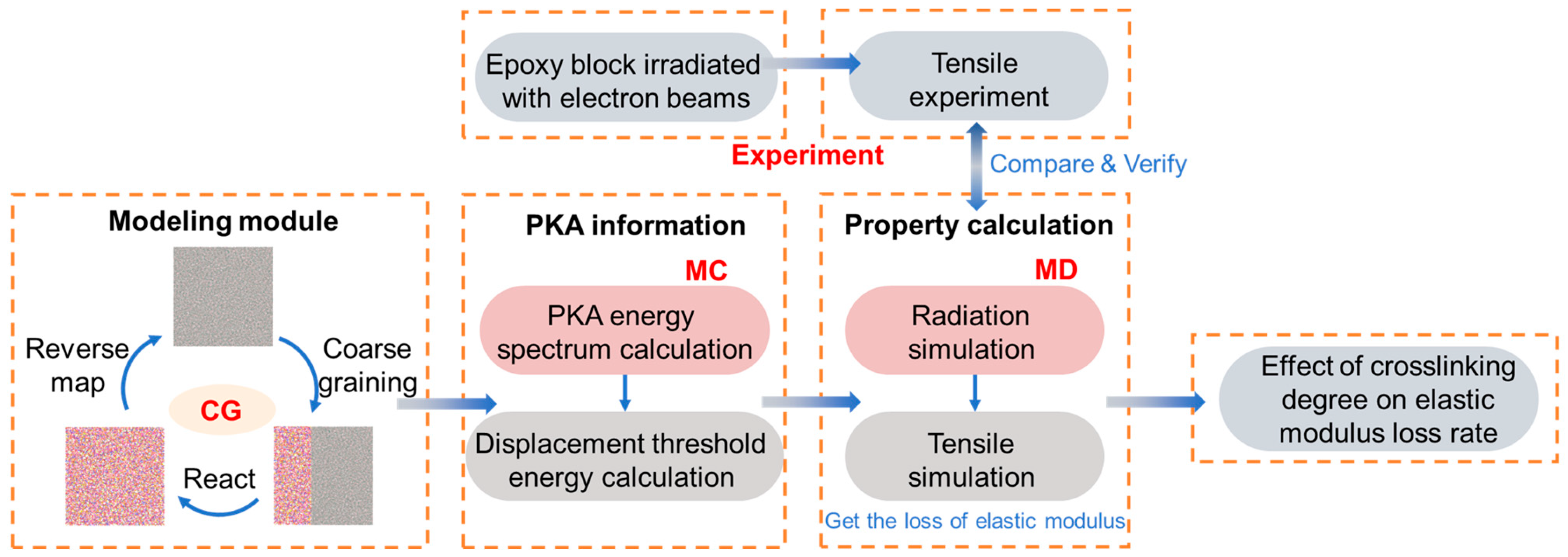
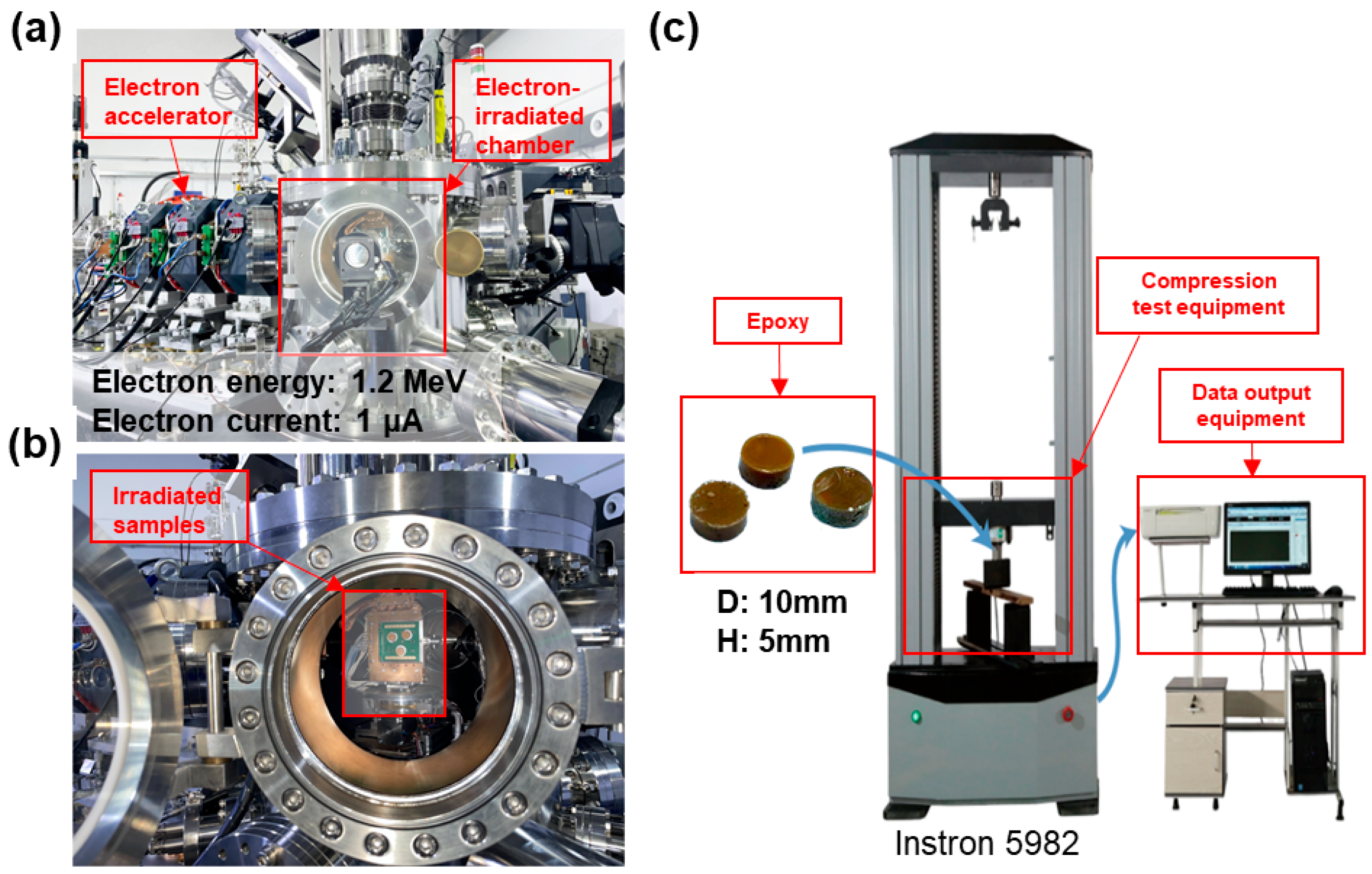
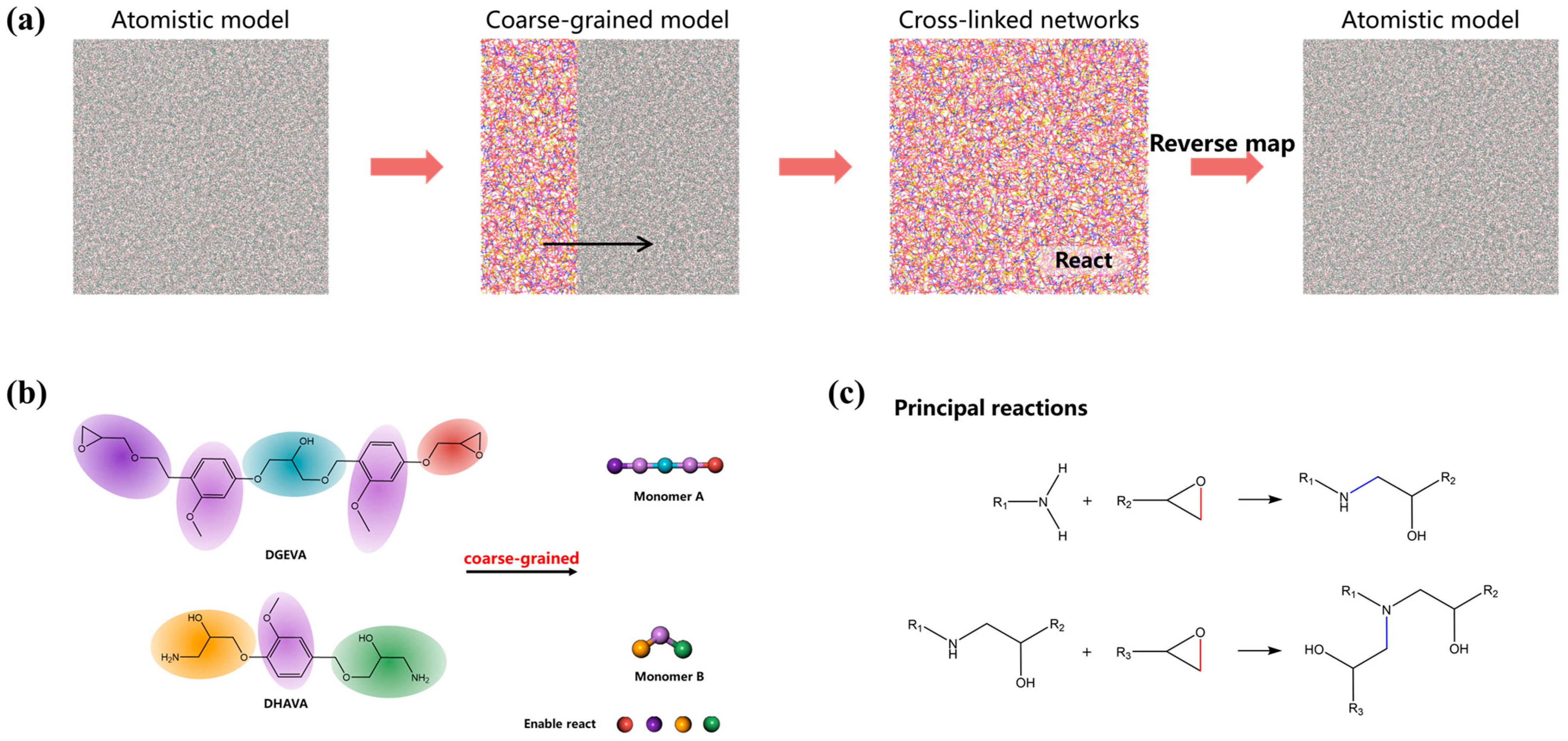

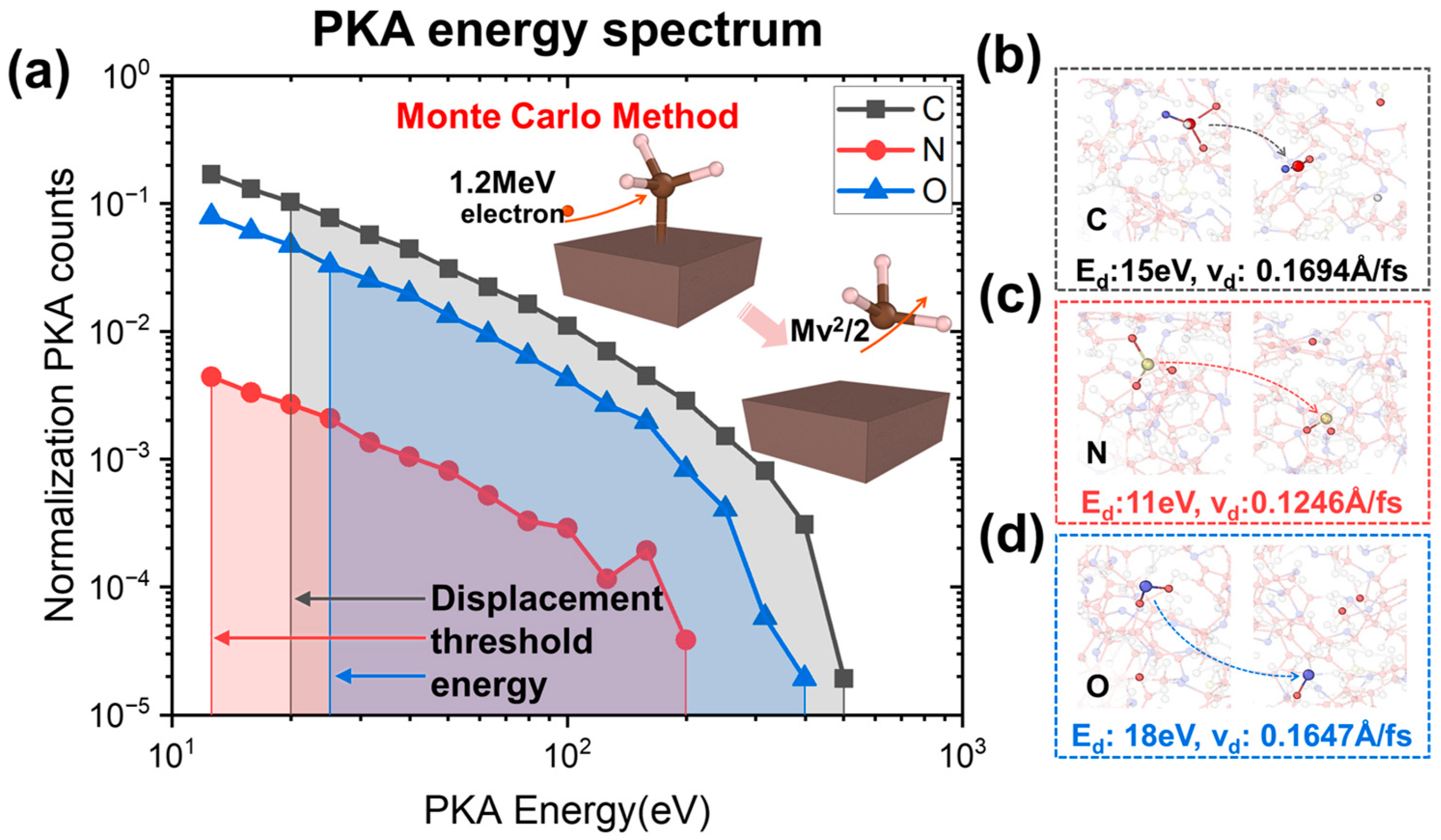

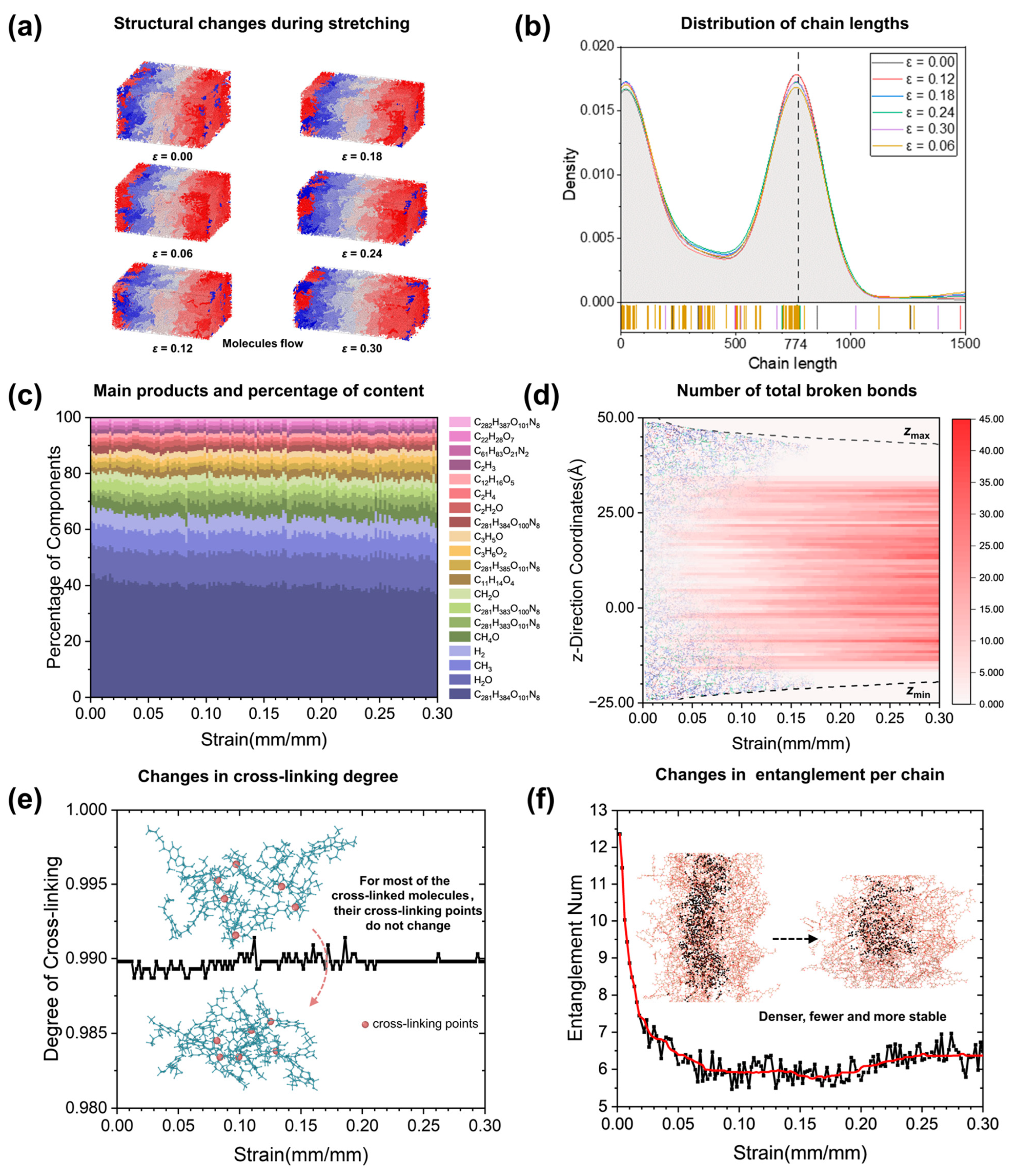
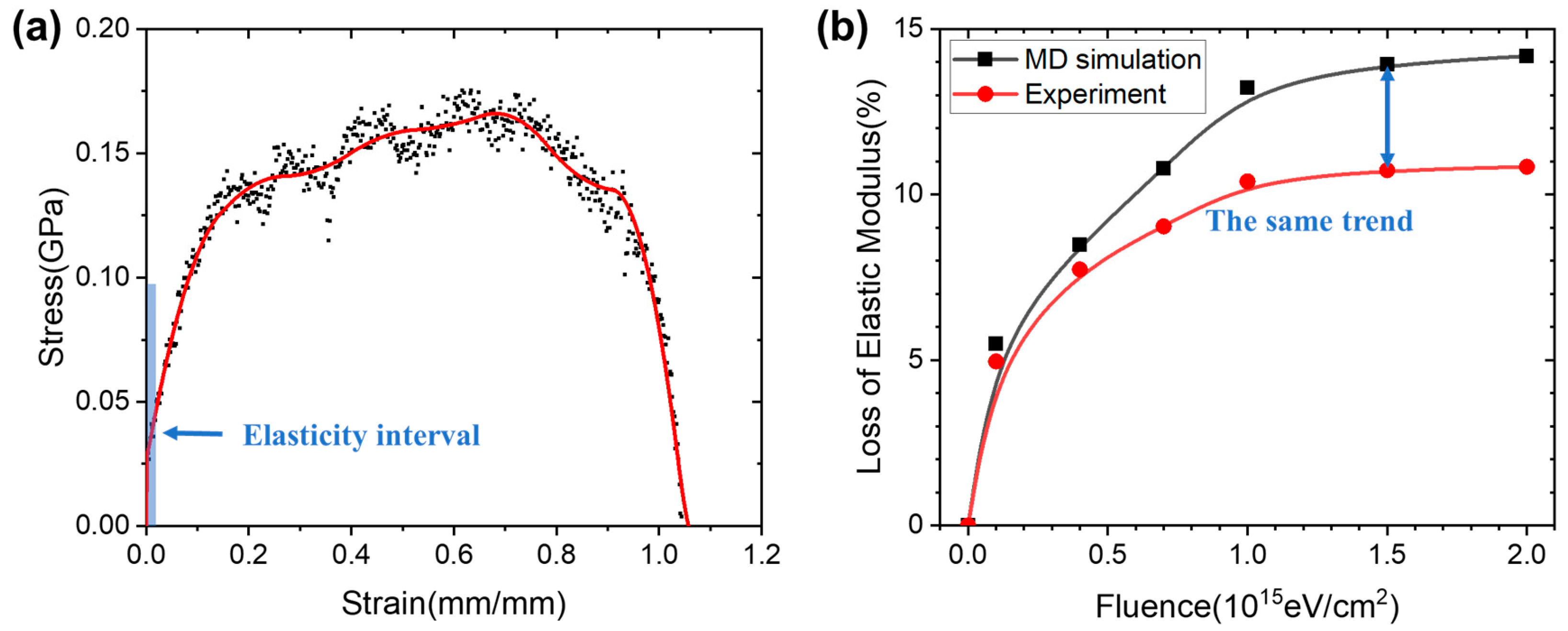
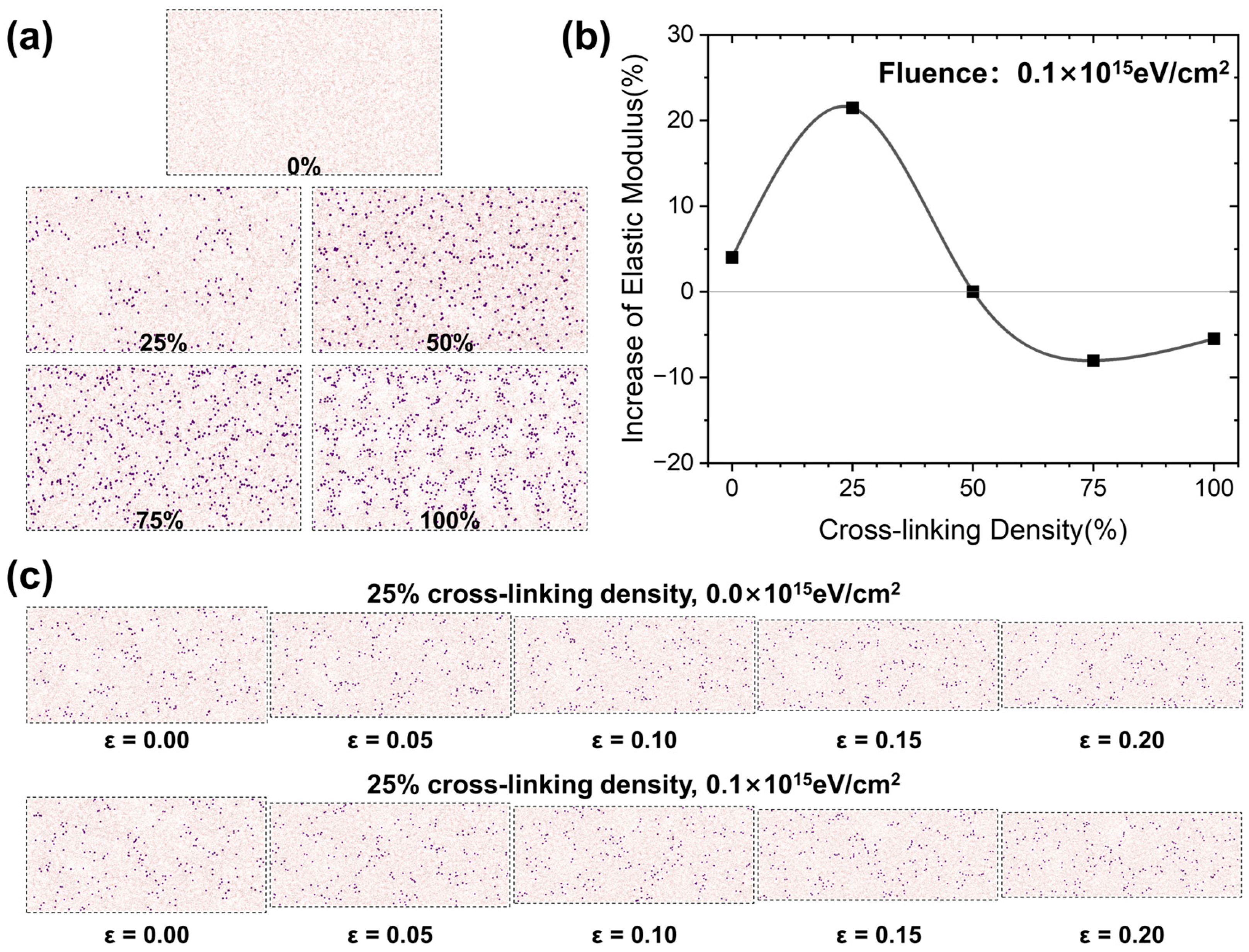
| Injection (1015 eV/cm2) | RI Before Stretching | RI After Stretching |
|---|---|---|
| 0 | 1.893 | 1.700 |
| 0.1 | 1.767 | 1.660 |
| 0.4 | 1.756 | 1.659 |
| 0.7 | 1.716 | 1.691 |
| 1.0 | 1.692 | 1.619 |
| 1.5 | 1.732 | 1.716 |
| 2.0 | 1.622 | 1.668 |
| Injection (1015 eV/cm2) | Percentage Loss of the Microhardness | Percentage Loss of the Elastic Modulus |
|---|---|---|
| 0.1 | 5.490 | 0.1498 |
| 0.4 | 8.480 | 0.1585 |
| 0.7 | 10.78 | 0.2024 |
| 1.0 | 13.23 | 0.2195 |
| 1.5 | 13.93 | 0.2368 |
| 2.0 | 14.18 | 0.3477 |
Disclaimer/Publisher’s Note: The statements, opinions and data contained in all publications are solely those of the individual author(s) and contributor(s) and not of MDPI and/or the editor(s). MDPI and/or the editor(s) disclaim responsibility for any injury to people or property resulting from any ideas, methods, instructions or products referred to in the content. |
© 2025 by the authors. Licensee MDPI, Basel, Switzerland. This article is an open access article distributed under the terms and conditions of the Creative Commons Attribution (CC BY) license (https://creativecommons.org/licenses/by/4.0/).
Share and Cite
Cong, L.; Guo, Z.; Zhang, X.; Li, H.; Jiang, H.; Jing, Y.; Yan, J.; Li, W.; Yang, J.; Li, X. Effect of Electron Beam Irradiation on the Percentage Loss of Tensile Modulus of Epoxy Polymer. Polymers 2025, 17, 447. https://doi.org/10.3390/polym17040447
Cong L, Guo Z, Zhang X, Li H, Jiang H, Jing Y, Yan J, Li W, Yang J, Li X. Effect of Electron Beam Irradiation on the Percentage Loss of Tensile Modulus of Epoxy Polymer. Polymers. 2025; 17(4):447. https://doi.org/10.3390/polym17040447
Chicago/Turabian StyleCong, Lingzhi, Zhibin Guo, Xin Zhang, Huyang Li, Hao Jiang, Yuhang Jing, Jihong Yan, Weiqi Li, Jianqun Yang, and Xingji Li. 2025. "Effect of Electron Beam Irradiation on the Percentage Loss of Tensile Modulus of Epoxy Polymer" Polymers 17, no. 4: 447. https://doi.org/10.3390/polym17040447
APA StyleCong, L., Guo, Z., Zhang, X., Li, H., Jiang, H., Jing, Y., Yan, J., Li, W., Yang, J., & Li, X. (2025). Effect of Electron Beam Irradiation on the Percentage Loss of Tensile Modulus of Epoxy Polymer. Polymers, 17(4), 447. https://doi.org/10.3390/polym17040447







